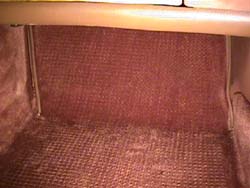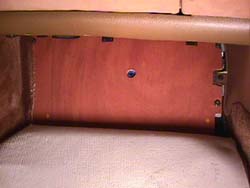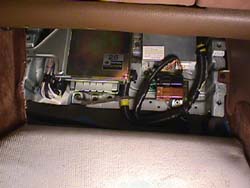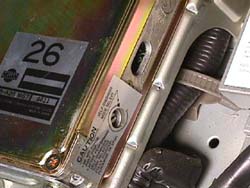1. Remove the passenger floor mat (1.).
2. Pull back carpet. It's held up with 3 spots of velcro (2.).
3. Remove the wooden floorboard (3.) (4 x 10 mm bolts)
4. The screw potentiometer is on the right side of the ECU, the coding LED is in the oval hole above it (4.).
5. Turn the ignition switch on, but do not start the engine.
6. Turn 'diagnostic mode selector' (pot on side) fully clockwise. Wait at least 2 seconds, then turn pot fully counter clock-wise. The ECU is now in Diagnostics MODE II
7. Read the codes from the flashing LED on the side of the ECU (or the check engine light). Long flash is first digit, short flash is 2nd digit, the codes are at the bottom of this page.
8. To exit MODE II, turn pot fully clock-wise. Wait at least 2 seconds, then turn the potentiometer fully counter clock-wise, or...
9. Start engine with the ECU in MODE II to enter MODE II - Heated Oxygen Sensor (O2) Monitor . The ECU is now monitoring the left O2 sensor. Warm the engine to normal operating temperature, then run at 2000 rpm for 2 minutes. Check that the LED blinks (or the check engine light) more than 5 times every 10 seconds at 2000 rpm.
10. To change to right sensor turn the ECU potentiometer clockwise with engine still running, wait 2 seconds, turn it back. Check the lights at 2000 rpm again for a similar switching condition.
NOTE: Light indicates signal from sensor to ecu. ON=rich, Off=lean. Blinking light means system is constantly adjusting between lean and rich which is normal. Any other indication would be abnormal and require further investigation. The switched on/off is 'closed loop', while a constant on or off is 'open loop'
11. To exit MODE II - Heated Oxygen Sensor Monitor, turn the potentiometer fully counter clock-wise and stop the engine.
LED codes for MODE II:
11: crank angle sensor circuit
12*: air flow meter circuit
13*: engine coolant temp. sensor circuit
14*: vehicle speed sensor circuit
21: ignition signal circuit
26*: boost pressure sensor
31*: ECU
32*: EGR function
33*: exhaust gas sensor circuit (left)
34: detonation sensor circuit
35*: exhaust gas temp. sensor circuit
42: fuel temp. sensor circuit
43*: throttle position sensor circuit
45*: injector leak
51*: injector circuit
53*: exhaust gas sensor circuit (right)
54: signal circuit from A/T control to ECU
55: NO malfunctions in the above
*Will cause the Check Engine light to come on under normal (MODE I) operating conditions.

2.

3.

4.


